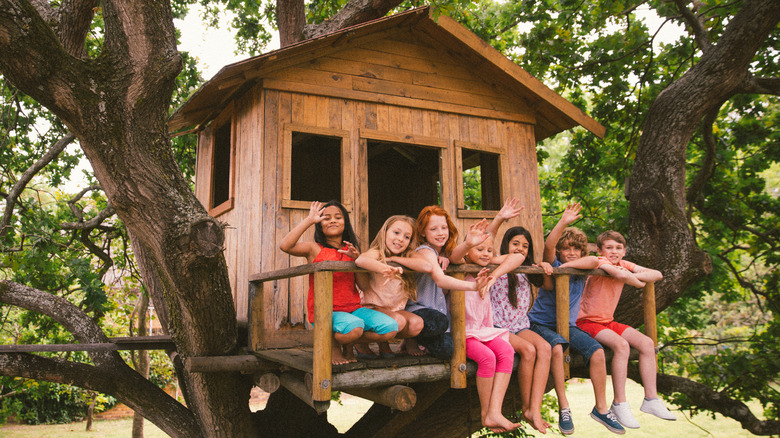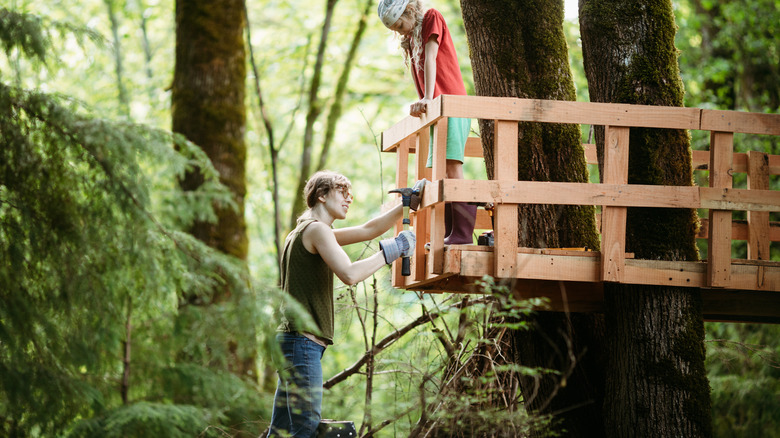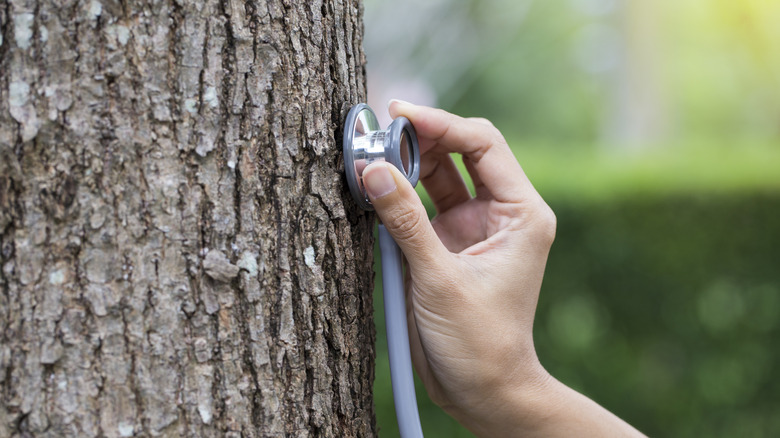These Sturdy Trees Are Best Suited For Building A Tree House
A tree house is a haven for children to let their imagination run wild and for adults to take a break from their day-to-day lives and connect with nature. But since you don't happen to reside in a supernatural home that'll fashion a tree house out of thin air whenever you need it (thank you for the unrealistic expectations, "The Haunting of Hill House"), you'll have to build one yourself. The first step is to choose the right tree. Ideally, deciduous trees are your best bet, as they have strong trunks, thick branches, and sturdy taproots.
Deciduous tree varieties like silver and red maple, tulip, hickory, beech, and several types of oak trees, such as red, white, and English, are best suited for tree houses. However, if you don't have any of these species in your backyard, a few coniferous and fruit trees work, too. Examples include Douglas fir, redwood, hemlock, apple, and cherry trees. However, choosing the right species is just one part of the puzzle. You must also determine if the tree is healthy and can support the structure.
Why deciduous trees are best suited for tree houses
Deciduous trees are best suited for building tree houses because they have strong trunks, branches, and roots and can easily bear the structure's weight. Plus, they can mostly tolerate a defoliation attack by insects. Additionally, they'll keep your tree house cool in the hot summer months by shading it and keeping the sun's glare and heat away. Conversely, these trees shed leaves in the winter, allowing sunlight inside the house and keeping its interiors bright and warm in the dreary cold months.
Maple is a great choice for a tree house. Maples grow super tall (between 33 and 150 feet) and are flexible. As such, Rocky Mountain, big tooth, and sugar maples are all good options. However, steer clear of shrub varieties, as they aren't as tall and have slim trunks that can't bear the load of your tree house. Alternatively, you can go with hickory. Hickory trees can grow to around 80 feet tall and are known for their eye-catching canopy. Pecan, water, shellbark, bitternut, and pignut are acceptable varieties. Oak trees, another suitable tree house option, contain tannic acid in their leaves and bark, making them resistant to insects and fungi. They'll stand firm for years to come and keep your precious tree house safe against diseases and, possibly, fire. Tulip trees are another great tree house choice. They grow 70 to 100 feet tall, have long lives, and provide beautiful flowers.
Tree health is essential
Even though deciduous trees are the best option for building tree houses, you must check a few boxes to ensure your hard work isn't in vain. Start by determining the health of the tree. Check the roots, trunk, and branches for fissures, suspicious holes, or root rot to ensure your chosen tree is healthy. Additionally, check for leaf discoloration, branches on the verge of death, sticky sap coming out of the trunk, and gaps in the canopy. If you find any of these signs, abandon the tree, as it won't provide a stable base for your house.
The tree's age is a matter of concern, too. You don't want to choose a tree that's too young because it'll continue growing. Similarly, you don't want to pin your hopes on a tree past its prime. To be on the safe side, look for fully grown trees that are around 15 to 30 years old. Plus, the tree should be sturdy enough to stand tall against winds and storms. Moreover, the tree should be tall, wide, and strong enough to support the height, width, and weight of your tree house when occupied.


